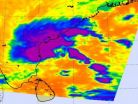(Press-News.org) Flying insects' altitude control mechanisms are the focus of research being conducted in a Caltech laboratory under an Air Force Office of Scientific Research grant that may lead to technology that controls altitude in a variety of aircraft for the Air Force.
"This work investigates sensory-motor feedback mechanisms in the insect brain that could inspire new approaches to flight stabilization and navigation in future insect-sized vehicles for the military," said Dr. Willard Larkin, AFOSR program manager who's supporting the work of lead researcher, Dr. Andrew Straw of Caltech.
The research is being conducted in a laboratory where scientists are studying how flies use visual information to guide flight in natural environments.
The scientists have found that, counter to earlier studies suggesting that insects adjust their height by measuring the motion beneath them as they fly, flies in fact follow horizontal edges of objects to regulate altitude. Remarkably, this edge following behavior is very similar to a rule they use for steering left and right and always turning towards vertical edges.
Straw noted that the flies don't have access to GPS or other radio signals that may also be unavailable in, for example, indoor environments.
"However, with a tiny brain they are able to perform a variety of tasks such as finding food and mates despite changing light levels, wind gusts, wing damage, and so on," he said. "Flies rely heavily on vision."
The scientists designed a virtual reality environment for their flying subjects which they found could regulate their altitude by enabling them to fly at the height of nearby horizontal visual, like the tops of rocks and vegetation.
"We developed a 3D fly tracking system which was our most significant technical challenge: localizing a fly in 3D nearly instantaneously," said Straw. "Next, we developed visual stimulus software capable of making use of this information to project virtual edges and textured floors in which we could modify the fly's sensory-motor feedback mechanism."
The 3D fly tracking system the researchers developed is significant because it will allow a rapid characterization of other fly behaviors with unprecedented levels of visual stimulus control.
Ultimately the scientists would like to build models of fly flight that can accurately predict behavior based on their sensory input and internal states.
"Additionally, being able to identify the neural circuits responsible for flight control would allow us to extend our understanding of how physiological processes implement behavior," said Straw.
In their next phase, the scientists will study more sophisticated flight behaviors, asking if the the fly creates a long-lasting neural representation of its visual surroundings or whether flight is only controlled by fast-acting reflexes.
INFORMATION:
ABOUT AFOSR:
The Air Force Office of Scientific Research, in Arlington, Virginia, continues to expand the horizon of scientific knowledge through its leadership and management of the Air Force's basic research program. As a vital component of the Air Force Research Laboratory, AFOSR's mission is to discover, shape, and champion basic science that profoundly impacts the future Air Force.
Air Force flight control improvements
2010-12-08
ELSE PRESS RELEASES FROM THIS DATE:
Are depressed people too clean?
2010-12-08
In an effort to pinpoint potential triggers leading to inflammatory responses that eventually contribute to depression, researchers are taking a close look at the immune system of people living in today's cleaner modern society.
Rates of depression in younger people have steadily grown to outnumber rates of depression in the older populations and researchers think it may be because of a loss of healthy bacteria.
In an article published in the December issue of Archives of General Psychiatry, Emory neuroscientist Charles Raison, MD, and colleagues say there is mounting ...
Small molecule may disarm enemy of cancer-fighting p53
2010-12-08
ORLANDO — A pioneering clinical trial is testing the effectiveness in leukemia of a small molecule that shuts down MDM2, a protein that can disable the well-known tumor suppressor p53.
Michael Andreeff, M.D., Ph.D., professor of Medicine and chief of Molecular Hematology and Therapy in the Department of Leukemia at The University of Texas MD Anderson Cancer Center, presented preliminary results of this ongoing Phase I study at the 52nd Annual Meeting of the American Society of Hematology. The clinical trial is under way at MD Anderson and five other sites in the United ...
Field of astrobiology more vital than ever
2010-12-08
New Rochelle, NY, December 7, 2010—NASA-funded research has uncovered a new life form on Earth, a microorganism that can not only survive but can thrive and reproduce by metabolizing arsenic, a chemical that is highly toxic for most other earthly organisms. This finding will revolutionize the field of astrobiology—the study of the origins, evolution, distribution, and future of life in the universe. Astrobiology, a peer-reviewed journal from Mary Ann Liebert, Inc.(www.liebertpub.com), has been the defining journal in this exciting area of study for the last decade. Table ...
NASA satellites see heavy rainfall and displaced thunderstorms in System 94B
2010-12-08
System 94B has not been classified as a tropical depression, but NASA satellite data has shown that it is creating heavy rainfall near India's southeastern coast. A second NASA satellite revealed that strong wind shear is continuing to push convection to the northwest of System 94B's center of circulation.
The Tropical Rainfall Measuring Mission (TRMM) satellite viewed an area of thunderstorms associated with System 94B near the east coast of India in the Bay of Bengal on December 7 at 0123 UTC. Data from TRMM's Precipitation Radar (PR) and Microwave Imager (TMI) showed ...
'Greener' climate prediction shows plants slow warming
2010-12-08
GREENBELT, Md. -- A new NASA computer modeling effort has found that additional growth of plants and trees in a world with doubled atmospheric carbon dioxide levels would create a new negative feedback – a cooling effect – in the Earth's climate system that could work to reduce future global warming.
The cooling effect would be -0.3 degrees Celsius (C) (-0.5 Fahrenheit (F)) globally and -0.6 degrees C (-1.1 F) over land, compared to simulations where the feedback was not included, said Lahouari Bounoua, of Goddard Space Flight Center, Greenbelt, Md. Bounoua is lead author ...
Strategy, court specialization driving increase in smart-phone litigation
2010-12-08
CHAMPAIGN, Ill. – The flurry of smart-phone patent suits at the U.S. International Trade Commission (ITC) is being driven by technology companies eager to capitalize on the speed and expertise of the specialized venue, says a University of Illinois patent strategy expert.
Business professor Deepak Somaya says that this current wave of patent litigation is a "clash driven by company strategies."
"Smart phones combine lots of amazing innovation from both computing and mobile telephony, and technology companies are seeing their patents as a potential source of leverage, ...
Feeling chills in response to music
2010-12-08
Los Angeles, CA (December 7, 2010) Most people feel chills and shivers in response to music that thrills them, but some people feel these chills often and others feel them hardly at all. People who are particularly open to new experiences are most likely to have chills in response to music, according to a study in the current Social Psychological and Personality Science (published by SAGE).
Researchers Emily Nusbaum and Paul Silvia of University of North Carolina at Greensboro asked students about how often they felt chills down their spine, got goose bumps, or felt ...
Good grades in high school lead to better health, study finds
2010-12-08
MADISON — The "A" grades that high schoolers earn aren't just good for making the honor roll — they also make them healthier as adults, too.
Studies have long shown that education is linked to better health, but new research by Pamela Herd, an associate professor of public affairs and sociology at the University of Wisconsin-Madison, shows that higher academic performance in high school plays a critical role in better health throughout life.
"How well you do in school matters," Herd says about the findings, which were published in the December issue of the Journal ...
Aging in Asia: Report release and conference in Beijing Dec. 8-10
2010-12-08
In many Asian nations, the percentage of the population 65 and older is growing rapidly -- a demographic shift that will pose new social and economic challenges to governments in the region. Preparing for the Challenges of Population Aging in Asia: Strengthening the Scientific Basis of Policy Development, a new report from five national science academies in China, India, Indonesia, Japan, and the U.S., explores the critical issues that rapidly aging populations will raise and identifies research that could help policymakers respond.
The report will be released at 6 p.m. ...
See off Alzheimer's with the color purple
2010-12-08
Ground-breaking research from Professor Douglas Kell, published in the journal Archives of Toxicology, has found that the majority of debilitating illnesses are in part caused by poorly-bound iron which causes the production of dangerous toxins that can react with the components of living systems.
These toxins, called hydroxyl radicals, cause degenerative diseases of many kinds in different parts of the body.
In order to protect the body from these dangerous varieties of poorly-bound iron, it is vital to take on nutrients, known as iron chelators, which can bind the iron ...




